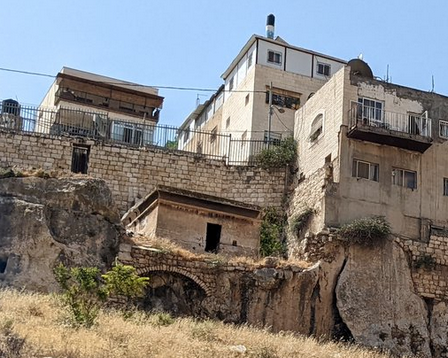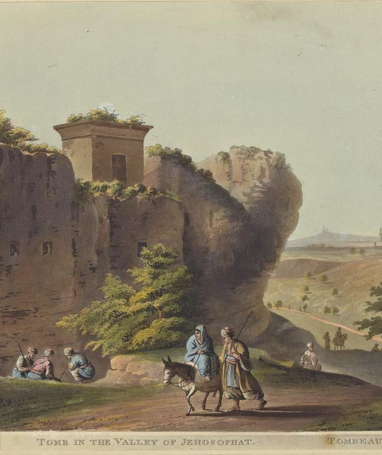Pharaoh's Daughter Lived Here

One of the first things King Solomon did when he ascended to the throne was to marry Pharaoh's daughter. In this way he made an alliance with Egypt and secured his southern border. Pharaoh conquered Gezer, exterminated its inhabitants and gave it as a wedding gift to the young couple. Solomon built Pharaoh's daughter a small residential palace befitting an Egyptian princess above the City of David.
"וַיִּתְחַתֵּ֣ן שְׁלֹמֹ֔ה אֶת־פַּרְעֹ֖ה מֶ֣לֶךְ מִצְרָ֑יִם וַיִּקַּ֣ח אֶת־בַּת־פַּרְעֹ֗ה וַיְבִיאֶ֨הָ֙ אֶל־עִ֣יר דָּוִ֔ד עַ֣ד כַּלֹּת֗וֹ לִבְנ֤וֹת אֶת־בֵּיתוֹ֙ וְאֶת־בֵּ֣ית יְהוָ֔ה וְאֶת־חוֹמַ֥ת יְרוּשָׁלִַ֖ם סָבִֽיב׃" (מלכים א' ג' א)
"וּבֵיתוֹ֩ אֲשֶׁר־יֵ֨שֶׁב שָׁ֜ם חָצֵ֣ר הָאַחֶ֗רֶת מִבֵּית֙ לָֽאוּלָ֔ם כַּמַּֽעֲשֶׂ֥ה הַזֶּ֖ה הָיָ֑ה וּבַ֜יִת יַעֲשֶׂ֤ה לְבַת־פַּרְעֹה֙ אֲשֶׁ֣ר לָקַ֣ח שְׁלֹמֹ֔ה כָּאוּלָ֖ם הַזֶּֽה׃" (מלכים א' ז' ח)
"פַּרְעֹ֨ה מֶֽלֶךְ־מִצְרַ֜יִם עָלָ֗ה וַיִּלְכֹּ֤ד אֶת־גֶּ֨זֶר֙ וַיִּשְׂרְפָ֣הּ בָּאֵ֔שׁ וְאֶת־הַֽכְּנַעֲנִ֛י הַיֹּשֵׁ֥ב בָּעִ֖יר הָרָ֑ג וַֽיִּתְּנָהּ֙ שִׁלֻּחִ֔ים לְבִתּ֖וֹ אֵ֥שֶׁת שְׁלֹמֹֽה׃" (מלכים א' ט' טז)
"אַ֣ךְ בַּת־פַּרְעֹ֗ה עָֽלְתָה֙ מֵעִ֣יר דָּוִ֔ד אֶל־בֵּיתָ֖הּ אֲשֶׁ֣ר בָּֽנָה־לָ֑הּ אָ֖ז בָּנָ֥ה אֶת־הַמִּלּֽוֹא׃" (מלכים א' ט' כד')
"וְאֶת־בַּת־פַּרְעֹ֗ה הֶעֱלָ֤ה שְׁלֹמֹה֙ מֵעִ֣יר דָּוִ֔יד לַבַּ֖יִת אֲשֶׁ֣ר בָּֽנָה־לָ֑הּ כִּ֣י אָמַ֗ר לֹא־תֵשֵׁ֨ב אִשָּׁ֥ה לִי֙ בְּבֵית֙ דָּוִ֣יד מֶֽלֶךְ־יִשְׂרָאֵ֔ל כִּי־קֹ֣דֶשׁ הֵ֔מָּה אֲשֶׁר־בָּֽאָ֥ה אֲלֵיהֶ֖ם אֲר֥וֹן יְהוָֽה׃" (דברי הימים ב' ח' יא)
יש אומרים ששיר השירים נכתב עבור בת פרעה ולראייה אומרת בת פרעה: "שְׁחוֹרָה אֲנִי וְנָאוָה, בְּנוֹת יְרוּשָׁלִָם; כְּאָהֳלֵי קֵדָר, כִּירִיעוֹת שְׁלֹמֹה. אַל-תִּרְאוּנִי שֶׁאֲנִי שְׁחַרְחֹרֶת, שֶׁשְּׁזָפַתְנִי הַשָּׁמֶשׁ (פסוק ה') ושלמה אומר: "לְסֻסָתִי בְּרִכְבֵי פַרְעֹה, דִּמִּיתִיךְ רַעְיָתִי" (פסוק ט'). וגם מתייחס אליה שלמה כאישתו: "לִבַּבְתִּנִי, אֲחֹתִי כַלָּה; לִבַּבְתִּנִי באחד בְּאַחַת מֵעֵינַיִךְ, בְּאַחַד עֲנָק מִצַּוְּרֹנָיִךְ." (פרק ד')
Among the houses of the village of Silwan, perhaps more correctly under the houses of the village, are the oldest complete remains of Jerusalem. This is a cemetery from the days of the First Temple, and probably even from the days of the Jebusites, a cemetery that is part of Jerusalem's “city-of-the-dead” located in the Kidron Wadi. It is interesting to note that in the ancient Land of Israel most of the cemeteries are found to the east of the settlements, probably because the wind that usually blows from west to east carries the stench of the dead away from the city.
המבנה שבתמונה, המכונה "קבר בת פרעה", הוא מן העתיקים ביותר שאפשר למצוא בנקרופוליס של ירושלים. מבנה זה חריג משום שבניגוד למערות הקבורה של עשירי ירושלים מאותה התקופה, מדובר במבנה בולט מעל הקרקע שאינו חלק ממערה טבעית. ככל הנראה, מעל המבנה התנוסס בעבר גג בצורת פירמידה שהוסר מאוחר יותר – מעל כרכוב מצרי הקיים עדיין. לא ברור האם מדובר בקבר או במבנה ששימש למטרה אחרת, אבל המאפיינים המצריים שבו נדירים לתקופתו והוא בן למעלה מ-3,000 שנה. הקבר נמצא בכפר סילוואן הנקרא על שם מעיין השילוח, מעל לעיר דוד, בדיוק המקום אליו העלה שלמה את אישתו בת פרעה.
העובדה שפרעה הסכים לתת את בתו לשלמה יוצאת דופן משום שבדרך כלל בבריתות מסוג זה, המלך החלש היה נותן את ביתו למלך החזק. יכול להיות ששלמה ניצל את חולשתה היחסית של מצרים בימי פרעה סיאמון. התנ"ך לא מציין, ואיננו יודעים את שמה של אותה בת פרעה ואין כל עדויות חיצוניות לכך שקשר מסוג זה התקיים. מאידך קיימות עדויות מוצקות לכך שהמלכים הפרעונים מעולם לא נתנו את בנותיהם לשליטים זרים, לכך שלא התקיימו קשרים דיפלומטיים או מסחר משמעותי בין ארץ ישראל לבית המצרים בתקופת שלמה המלך, וכמו כן ישנו מיעוט מטריד של ממצאים ארכיאולוגיים מתקופת שלמה בכלל.
On the other hand, the paucity of Egyptian influence in the Land of Israel at the time when the Pharaoh's daughter's tomb was built increases the mystery. Why and for whom was this structure built for?
אגב, נישואי שלמה המלך לאישה מצרית גורמות לבעיות הלכתיות לא פשוטות עבור הממסד הדתי היהודי ולאורך הדורות רבים חכמי הדת יצאו נגד נישואים אלו, למשל בתלמוד הבבלי: "אמר רב יהודה אמר שמואל בשעה שנשא שלמה את בת פרעה ירד גבריאל ונעץ קנה בים ועלה בו שרטון ועליו נבנה כרך גדול [של רומי]" – כלומר יום נישואי שלמה לבת פרעה הוא היום בו נוצרה רומא (שהחריבה בסופו של דבר את ישראל) – היום בו נמשו רומוס ורומולוס ממימי הטיבר?
Pharaoh's Daughter's Tomb painting by Luigi Meier, around 1804:

Additional sources:
https://mechon-mamre.org/i/t/t3004.htm
https://bibleinterp.arizona.edu/articles/2000/ash248001
https://www.daat.ac.il/DAAT/tanach/divreyha/shlomo-2.htm
https://he.wikisource.org/wiki/%D7%A9%D7%91%D7%AA_%D7%A0%D7%95_%D7%91
https://en.wikipedia.org/wiki/Pharaoh%27s_daughter_(wife_of_Solomon)
https://en.wikipedia.org/wiki/Siamun
https://he.wikipedia.org/wiki/%D7%91%D7%AA_%D7%A4%D7%A8%D7%A2%D7%94_(%D7%90%D7%A9%D7%AA_%D7%A9%D7%9C%D7%9E%D7%94)
https://he.wikipedia.org/wiki/%D7%A1%D7%99%D7%9C%D7%95%D7%90%D7%9F
https://he.wikipedia.org/wiki/%D7%9C%D7%95%D7%90%D7%99%D7%92%27%D7%99_%D7%9E%D7%90%D7%99%D7%99%D7%A8
https://ia801600.us.archive.org/BookReader/BookReaderImages.php?zip=/16/items/gri_33125008694941/gri_33125008694941_jp2.zip&file=gri_33125008694941_jp2/gri_33125008694941_0101.jp2&id=gri_33125008694941&scale=2&rotate=0
https://he.wikipedia.org/wiki/%D7%9C%D7%95%D7%90%D7%99%D7%92%27%D7%99_%D7%9E%D7%90%D7%99%D7%99%D7%A8
https://en.wikipedia.org/wiki/Pharaoh%27s_daughter_(wife_of_Solomon)
(Anecdote authored by: דניאל)
(Number of views: 75)
